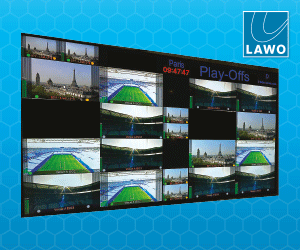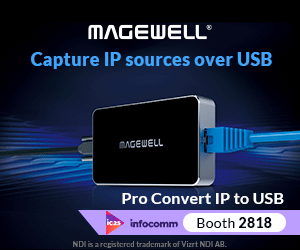Sharjah Television, broadcaster, TV, tapeless

Sharjah’s state broadcaster, Sharjah Television, is probably one of the last of the state broadcasters in the GCC to join the bandwagon to modernise its facility but it has been coming for awhile under the leadership of Amna Khamis Al Nakhi, managing director of Sharjah Radio and TV, and CEO of Sharjah Media Corporation (SMC).
In the last year, the station has been working towards acquiring high-quality content and engaging a new and wider audience focused around Arab and Muslim family values. Last month, the broadcaster also announced that a better programming grid was in the offing later this year.
In fact, SMC recently partnered with Lambie-Nairn to give both Sharjah TV
and SMC a new look to signal, what Al Nakhi, called "our commitment to be among the top public-service broadcasters in the region".
To make all of this possible, Sharjah TV recently contracted systems integrator Salam Media Cast to deploy an end-to-end, fully digital file-based workflow at its facility. Initially, the upgrade was to be undertaken as two phases with production and playout being followed by archiving. However, it was later decided that the two phases would be combined.
"Sharjah TV was looking for scalable solutions to archive content in a digital file-based format," explains Sami El Shafai, executive director, Salam Media Cast.
"The overall project consists of the deployment of server-based technology in an effort to streamline operations and enhance production capabilities. The need for a digital file-based archive has become a critical component and the intent is to archive content in the same file-based format and to totally eliminate, over time, traditional videotapes from the workflow."
Four key suppliers have been brought together for this project. Avid will provide solutions from ingest to post with automated playout from Sharjah TV’s studios while Harris will offer transmission playout and channel management solutions. VIZRT will provide the graphics while Front Porch Digital will supply the archiving solution.
Two core areas will be covered as part of this project, namely news and programming.
The first part of the workflow includes an Avid production and playout solution.
"Sharjah TV is an existing Avid user," explains Sami El Shafai, executive director, Salam Media Cast. "So they wanted to upgrade their Avid setup. Avid also offered to trade in their existing equipment with their newest solutions, so it was the ideal choice in terms of both user preference and the technology itself," he says.
The production system will be based on Avid’s Unity ISIS servers for both news and programming. This replaces the previous Avid Media Network at Sharjah TV.
Avid’s Asset Management System, Interplay will replace the previous Media Manager, and will manage the media movement as well as the metadata. The video production process, both for news and programmes, will be based around the ISIS shared storage and its Interplay asset management, giving all users rapid and simultaneous access to video material.
Additionally, the iNews Newsroom Computer System (NRCS) will provide scriptwriting and running order production facilities, as well as the ability to add character generator events to stories from a single user interface. Avid Interplay will provide a central point for users and technical staff to capture, log, locate, store and delete Avid assets.
The workflow sees the iNews NRCS as the genesis of all stories, with a preliminary running order being created for each show. iNews also allows the creation of resourcing sheets, to allocate crews and equipment such as cameras and vans to each story.
From here, Viz Content Pilot provides a centralised and uniform structure to manage and play out the graphic elements. The templates created by the artists will be stored on a hub and shared by the users. iNews clients can preview the VIZ templates using the Active X Plugin and type up CG text, and save it with the story on iNews, including timings such as start time and duration. When the running order is sent to the Avid Command playout tool, any CG instructions are passed onto Vizrt.
Any automatic triggering timings saved with the event (such as start time and duration) will ensure that the CG event is automatically played by Viz. Equally, it will be possible to play any CG events manually.
Contribution feeds, external lines or studio feeds are recorded to the ISIS using an AirSpeed Multi Stream unit.
This is controlled by Avid Capture Manager client workstations. The material is available within seconds from the time the material is ingested and is available to the Avid production tools for viewing, logging and editing. At ingest, recorded media is registered with the Avid Interplay production asset management system, and associated data can be searched by any Interplay clients on the system.
Avid Interplay provides comprehensive administration tools for mission-critical performance. Using either pre-configured roles or customised user privileges, access to assets can be controlled individually or by groups, depending upon the need of each facility. Users can be assigned roles (such as reviewer or editor) that determine their access capabilities. On a project level, users can be granted operational privileges for specific files or folders and folders can be designated for certain types of users.
The Avid Interplay Access tool provides powerful search, check-out/check-in, revision control, and administration features at the desktop. In addition, all of the Avid editing clients can directly access the Interplay asset management system via an "Interplay Window" available on the editor’s GUI.
This allows production staff to easily navigate and organise assets, add or modify media objects such as master clips, sequences, and effects or work with graphics files. Sub-clips created on Assist can be located and dragged into an editing bin on the Avid NewsCutter editors. With many basic and advanced effects such as blur and colour correction, users will be able to finalise packages at their desktop.
Here, the Avid AirSpeed Multi Stream servers for playout are controlled by Avid Command, which receives the running order information from iNews and translates it into a playlist with video events. The playlist is controlled manually by the playout operator, who decides when to roll out each package and graphic.
"Vizrt will be used to play out graphics under the control of iNews Command. Vizrt has a 103-inch screen driven by the Viz engine. This will provide a new look to the channel," explains El Shafai.
PROGRAMME PRODUCTION
Progamme production is designed differently from News. The media required for each "playout-ID" for programmes is generated by Harris Broadcast Master and will be ingested and stored under the relevant folder using Avid.
MCR PLAYBACK
Harris Broadcast Master will generate the scheduling list for playout. This list is dynamically exchanged with the ADC automation system. QCd sequences will be sent to playout and handled by ADC.
"Besides creating schedules and managing playlists, Broadcast Master also gives the sales and marketing teams tools to manage their acquisition and commercial client profile," says El Shafai.
An integral part of the playout is also the Front Porch DIVArchive solution. This will manage an Oracle/Sun SL3000 Robotic Tape Library and supports up to 56 tape drives. It offers nondisruptive scalability of up to 3000 slots providing as much as 1.5 PB of storage capacity when used with Oracle/Sun T10000 tape drives and cartridges.
ARCHIVE MANAGEMENT
Any material that needs to be archived will be sent to Avid Interplay using Interplay Access, Assist or a NewsCutter. These allow the end user to archive the files. The Avid Interplay Archive database with FPD tracks files stored in an external storage library, enabling Interplay users to look for archived and online media simultaneously using any Interplay Assist application on a networked PC.
"This workflow will help Sharjah TV achieve its business and operational objectives, and revolutionise its current production workflows by giving its journalists the power to produce and edit their own stories while providing different levels of access rights to news and post-production staff according to each user’s needs. Besides providing standard user interfaces to all creative staff in the news and postproduction business areas, this workflow also provides a fully non-linear production environment where simultaneous access to material is a given. It also provides the ability to store material long-term whilst keeping track with a rich asset management database," adds El Shafai.














































































.jpg)